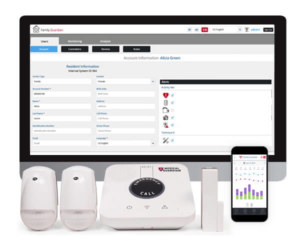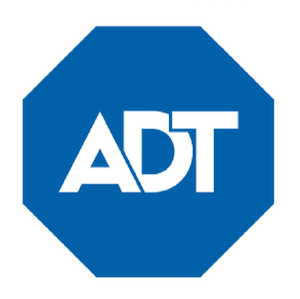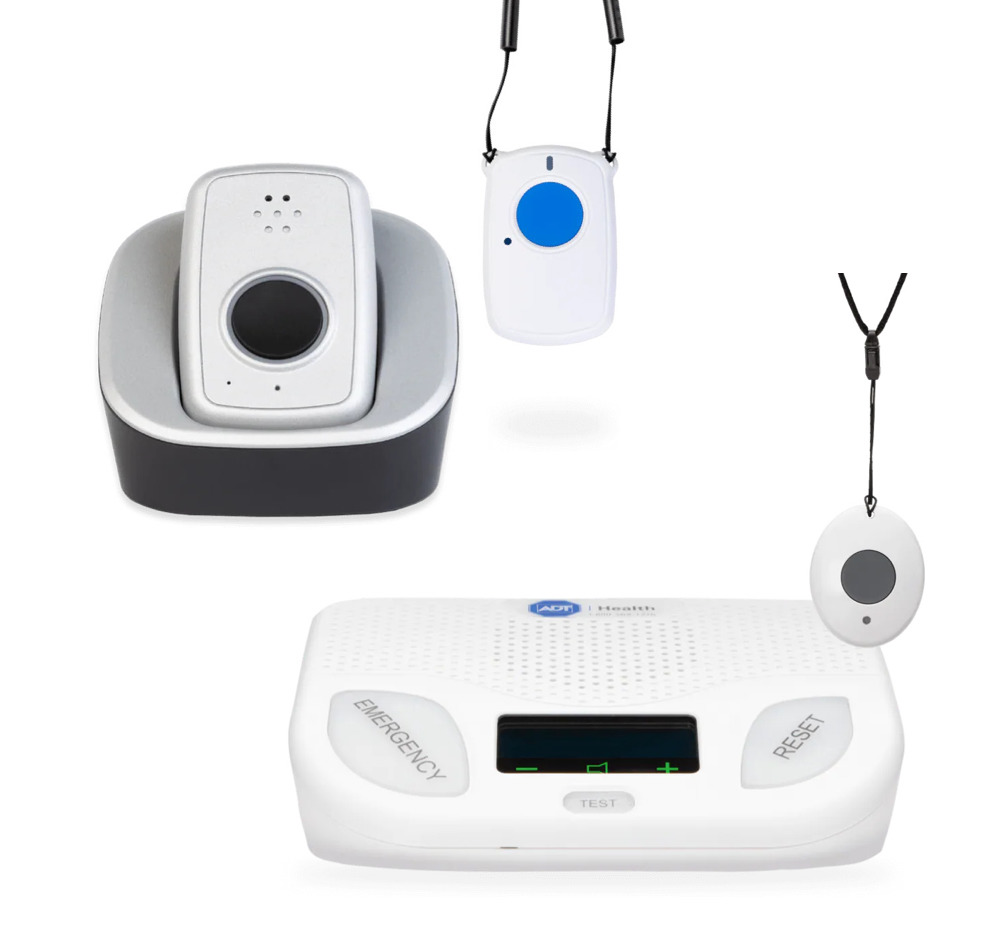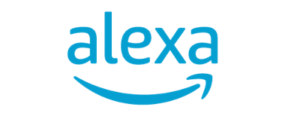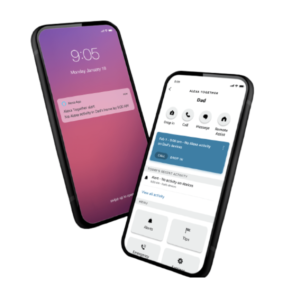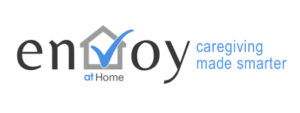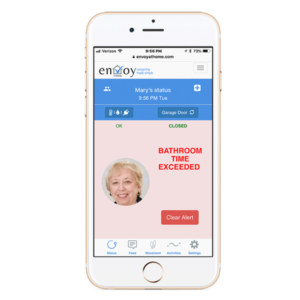Best Monitoring Systems For Elderly In The Home
Home monitoring systems are specialized older adult safety devices to help vulnerable adults stay in their homes longer.
AgingInPlace.org keeps our resources free by working as an affiliate partner with some companies mentioned on our site. These partnerships or the commission we may earn do not affect our opinions or evaluations of the products we mention. Our reviews are solely based on our research methodology and from input from our AgingInPlace.org Advisory Board. Learn more about our ad policies.
Best Monitoring Systems For Elderly In The H...
Products carousel
Most people think of medical alert systems when searching for older adult safety devices for their loved ones. But aging-at-home technology has advanced exponentially in recent years to meet the growing demand for services and the need for more specialized remote monitoring. These systems are no longer one-size-fits-all devices. They offer special services, and some can even be customized to older adults’ specific needs.
For example, depending on the home monitoring system one uses, caregivers can be alerted to risky behaviors such as confusion, medication adherence, bathroom usage, or other fall risks.
When considering monitoring systems for elderly individuals at home, “It’s best to do lots of research and speak to representatives from each company as all systems have their pros and cons,” said Gareth Mahon, CEO of The CareSide, a home care and nursing service for the elderly and disabled.
To help you narrow your search, our team of experts at AgingInPlace.org looked at several home monitoring systems, determined which were best for certain individuals, and selected our top brands. Here’s what we found.
Key Takeaways
- Monitoring systems are not one-size-fits-all devices
- Some home monitoring systems for the elderly can alert caregivers about health or cognitive issues
- Other home monitoring systems can detect falls and provide rapid emergency response
- Some home monitoring systems are more private and only alert assigned caregivers remotely via an app
- New technology offers virtual caregivers that can learn a user’s behaviors. These services are usually more expensive
How Monitoring Systems Work for the Elderly in the Home
Home monitoring services are designed to give caregivers and their aging loved ones peace of mind while also enabling them to age in their homes as long as possible. Since older adults can have a wide range of health and mobility issues, these systems work differently depending on the type of service. Some alert first responders in the event of an emergency. Others notify caregivers if risky behavior is identified. Some provide medical data to the user’s healthcare team. Read on as we explore the different monitoring systems for elderly individuals in the home.
Different Types of Monitoring Systems
Monitoring systems for the elderly offer a variety of features. These systems can be used alone or paired with another monitoring system depending on your loved one’s needs. Common types of monitoring systems include:
- Voice-activated services
- Movement sensors
- Video monitoring
- Personal emergency response systems
- Medical monitoring
- Comprehensive artificial intelligence home systems
Benefits of Monitoring Systems for the Elderly in the Home
Monitoring systems for the elderly provide numerous benefits beyond helping individuals age at home. These include:
- Early detection of cognitive and medical health issues
- Peace of mind for caregivers and their loved ones
- Heightened home security and monitoring of safety issues, such as room temperature spikes or drops
- Reduced healthcare costs
- More opportunity to connect remotely with loved ones farther away
Top Monitoring Systems for the Elderly in the Home
Here are our top elderly monitoring systems, which include personal emergency response systems, voice-activated services, movement sensors, video monitoring, medical monitoring, and even comprehensive artificial intelligence (AI) home systems.
Type: Personal emergency response system
Price: $29.95–$37.95/month for at-home systems. At-home system with cellular connection requires a one-time $149.95 equipment fee.
Features:
- 24/7 monitoring that links users directly to emergency operators
- Mobile options available
- Fall detection available for an additional monthly cost
- Wearable devices are water-resistant
- Two-way speaker with most devices
- Jewelry accessories available to disguise wearable pendants
- Smartwatch model available, but it doesn’t include fall detection
Editor’s Choice
What Is Editor’s Choice?
Our team of editors and writers choose a product from each article that stands out based on our extensive research of the products we review. While it may not always be the highest-scoring product in the lineup, we’ve chosen the product based on its overall value to our audience.
Why We Chose This Product:
We like Medical Guardian’s multiple monitoring system options: in-home, mobile, and smartwatch. These options give older adults more options to choose a medical alert system that’s best for their activity level. Medical Guardian is one of the only medical alert brands to offer voice-activated wall buttons, another standout feature for monitoring older adults at home. Voice activation helps extend the wall button’s coverage area since the user doesn’t need to be within arm’s reach to contact the monitoring center.
Medical Guardian is one of the top brands in our best medical alert systems review. The brand’s website is easy to navigate, which makes it easy to purchase a medical alert subscription directly online. Medical Guardian offers landline or cellular network connection at-home systems at affordable monthly prices ($29.95 per month for landline and $37.95 per month for cellular). The Mobile 2.0 and Mini Guardian are mobile systems that connect to the 24/7 monitoring center inside or outside the home. Fall detection is available for an additional $10 per month for all Medical Guardian systems except the MGMove Smartwatch. This is because natural wrist movements can potentially trigger false alarms.
The mobile device or at-home help button lanyard will connect to the monitoring center if it detects a fall. If there is no response or the user tells the monitoring center agent it’s a medical emergency, the agent dispatches emergency responders to the user’s location. Medical Guardian also offers push- and voice-activated wall buttons that connect to the monitoring center. These wall buttons can be placed in high-risk fall areas like the bathroom or near the bed in case of an emergency.
See our full Medical Guardian Review.
Type: Personal emergency response system
Price: $29.99–$39.99 per month
Features:
- Safe home temperature monitoring with in-home systems
- Systems are connected to 24/7 ADT-owned and -operated monitoring centers
- Landline and cellular connections are available for in-home systems
- Mobile medical alert system option
- Additional pendants are available to monitor multiple people in one home
ADT is also featured in our best medical alert systems review. The well-known security company offers three medical alert system options that connect to a 24/7 monitoring center: Medical Alert Basic (landline connection), Medical Alert Plus (cellular connection), and On-The-Go (wireless mobile system). We like the standard three option compared to some medical alert companies that offer 5–10 packages. First-time shoppers may like the more simple three choices.
Safe home temperature monitoring is a built-in feature for both the ADT landline and cellular in-home systems. The base station verbally alerts the medical alert user and notifies a monitoring center agent if the home temperature is less than 35 degrees or more than 105 degrees. The agent will dispatch emergency services to the home if they can’t get in touch with the user or primary emergency contact regarding the unsafe temperature. This is an excellent safety feature to help catch stove fires, an overheated oven, or to monitor if the home heating system is working properly in the winter, especially in colder climates.
ADT medical alert systems do have a few drawbacks. Fall detection is not available for the Medical Alert Basic in-home system, and the connectivity from the help button to the in-home base station is only 300 feet for the Medical Alert Basic and 600 feet for the Medical Alert Plus.
See our full ADT Review
Type: Voice-activated service
Price: $19.99 per month or $199 per year. (Free 30-day trial offer going on now). Plus the cost of an Alexa device for the user and caregivers.
Features:
- Keeps up with users’ activities via the activity feed
- Can alert caregivers to specific activities, such as when door sensors are activated
- Alexa will notify caregivers if the user hasn’t communicated with the device within a certain period
- A user can ask Alexa to call for help, and Alexa will immediately contact assigned caregivers
- Enables caregivers to “drop in” on loved ones to visit or assess worrisome conditions
- Can hook up to third-party fall detection devices, which will alert caregivers to falls
It seems like anything can be found on Amazon. Now, the marketplace offers home monitoring for older adults via its Echo device. Alexa Together is available for a small monthly fee, though all parties—the user and all caregivers—will need an Amazon account, an Echo device in their homes, and the free smartphone app. While any Echo device will work, it’s best if the loved one needing monitoring has an Echo Show device, which enables video drop-ins for emergencies.
Alexa Together works by reminding your loved one about upcoming doctor’s appointments or when to take medications. It also keeps caregivers in the loop about their loved one’s activities via the accessible activity feed. But you can also get important notifications. For example, if your loved one falls and asks Alexa for help or if a paired device detects a fall, the app will immediately contact the 24/7 Urgent Response monitoring center and caregivers. Alexa Together can also be paired with Alexa-enabled devices that have sensors that detect when medicine cabinets or front doors are opened, and they can immediately alert caregivers about these activities.
Type: Movement sensors
Price: $399 for starter equipment package with eight sensors and a hub. $99.99 monthly service charge. Additional sensors can be purchased for $29.99 each.
Features:
- Uses discrete sensors to track behavior: no cameras, microphones, listening devices, GPS tracking, or wearable technology
- Sensors can be placed on front doors to monitor when someone opens the door
- Bathroom sensors can detect toilet frequency and duration
- System enables remote unlocking of the front door for first responders
When older adults experience cognitive decline, hazards like bathrooms, stairs, and doorways can become a concern. EnvoyatHome tracks your loved one’s activities using discrete sensors placed around the house and alerts caregivers via the app if their loved one’s behavior is out of character. For example, if your family member uses the bathroom more often than usual, it may signify a urinary tract infection. In addition to providing real-time alerts, envoyatHome also stores the data to detect trends that can indicate a decline in mental or physical health.
Older adults with dementia or Alzheimer’s disease are prone to wandering and getting lost and disoriented and are at a greater risk for falls and injuries. We appreciate that envoyatHome acts as a door alarm for elderly individuals by notifying caregivers if their loved one attempts to leave the house.
The system can also detect pacing and behaviors that suggest confusion. EnvoyatHome can also be programmed to monitor compliance with medical orders, such as avoiding stairs, staying hydrated, or taking medication. In an emergency, it allows caregivers to remotely unlock the front door to allow access for first responders.
Type: Video monitoring
Price: $52.99 one-time cost for E1 Pro indoor camera
Features:
- Equipped with dual-band Wi-Fi security camera with full HD video and motion detector
- Cameras allow for two-way audio
- Cameras have night vision for improved visibility of nighttime videos
- Cameras can do a 355-degree pan and 50-degree tilt
- Remote live view available anytime to check on loved ones
- Can be used to discreetly check on the care your loved one receives from home health or other caregivers
Baby monitors are a godsend for many new parents, but they can be helpful for caregivers who want to keep their eyes on their adult loved ones. Just like nanny cams, video monitoring systems for elderly individuals in the home can help caregivers monitor how well hired aides or sitters are meeting their loved one’s needs and ensure they are being treated with dignity.
The Reolink E1 Pro security cameras stand out to us because they can be set to record at certain times of the day or 24 hours a day, seven days a week. If needed, you can go back and check if your loved one got up during the night or how they fell when they were home alone. Reolink E1 Pro security cameras can also help you determine whether your loved one may require a higher level of care.
Type: Medical monitoring
Price: $59.99 per month and one-time $25 activation fee for the Pro Health service. Most add-ons require an additional $55 one-time fee.
Features:
- 24/7 emergency response
- Physician-on-demand services
- 24/7 medication reminders
- Works with add-on devices from Pro Health system such as glucose monitor, blood pressure monitor, and pulse oximeter
- Non-contact thermometers and weight scales are also available to track temperature and weight
Managing health issues can feel difficult and confusing for many older adults and their families. Medical monitoring services can help streamline health data, improve treatment adherence, and deliver early identification to providers, taking home monitoring for elderly individuals to a whole new level. After reviewing the top medical monitoring services, we recommend Electronic Caregiver’s Pro Health service.
Pro Health provides 24/7 advanced remote patient monitoring with voice technology using connected devices to monitor key vitals and health indicators, such as blood sugar levels, blood pressure, oxygen levels, and heart rate. That data is stored and shared automatically through the Care Circle App and integrated health dashboards. Alerts and actionable data are sent to care teams in real time if readings are concerning. This home health monitor also includes 24/7 emergency response and physician-on-demand services.
Type: Comprehensive AI home service
Price: About $400 per month (company estimates cost at $13.30 per day)
Features:
- Interactive virtual caregiver is programmed to recognize users and can learn their behaviors
- System can also give memory stimulation exercises, medication reminders, or rehab for agility and strength
- 24/7 emergency response available
- Vitals monitoring available
- Certified professional installment of Addison touch screens within home
One of the most innovative elderly monitoring systems on the market is Addison Care: a modern, 3D-animated, virtual caregiver service that turns a loved one’s residence into a digital smart home devoted to their health. It provides chronic care management, rehabilitation, behavioral health, and care coordination via interactive video monitors set up around your loved one’s house. A virtual caregiver interacts with your loved one and is programmed to recognize users and respond appropriately if they appear sick or unsafe.
Addison Care can be programmed to provide several therapeutic services, including memory stimulation exercises, medication reminders, and rehab for agility and strength. The system also offers 24/7 emergency response home security and vitals monitoring, if needed. Though it may sound like an impossible device to set up and use, Addison Care will send certified professional installers to set up monitors around your home and teach you how to use them. But this service doesn’t come cheap—it costs roughly $13 a day or $400 a month. While that may sound expensive at first, it pales compared to the cost of assisted living or 24-hour skilled nursing care.
How to Choose the Right Monitoring System for the Elderly in the Home
When shopping for a monitoring system, you’ll want to ensure the device meets your loved one’s specific needs. You should ask yourself certain questions before purchasing a home health monitoring system:
- What health issues does your family member have and do they require regular monitoring?
- Does your loved one become confused or are they prone to wandering?
- Is your family member at risk of falling?
- Do hired aides stay with your loved one part-time or full-time?
- Are you concerned about your loved one’s eating or bathroom habits?
- Will your loved one wear a lanyard or wristband device?
- How much is your budget for a monitoring system for the elderly in the home?
Bottom Line
Technology has taken remote caregiving to new levels, with various services designed to help elderly individuals age at home as long as possible. “Someone who wanders will be best with a GPS tracking system which works out of the home,” Mahon advises. “Some systems have built-in alarms which can be set to prompt users to take medications or meals.”
But these specialized services do come at a price, which can be pretty steep depending on the system and services needed. Considering the cost of assisted living or 24-hour skilled nursing care, you can rest assured knowing that elderly monitoring services are a bargain at a fraction of the price. And the peace of mind they give both the caregiver and the person being monitored? Well, that’s priceless.
Frequently Asked Questions
-
Most people are familiar with at-home medical alert systems, which offer quick responses at the touch of a button. But there are many elderly monitoring systems on the market designed to meet more specific needs of elderly individuals, including fall detection, bathroom monitoring, health trend tracking, and wandering alerts.
-
Medical monitoring systems are a great way to keep tabs on your loved one’s health. Our top pick is Electronic Caregiver Pro Health, a remote monitoring system that uses add-on devices to check everything from blood-sugar levels and heart rate to body weight and temperature.
-
The activities or issues that caregivers monitor can vary, depending on the needs of their loved ones. For example, medical monitoring can be helpful for older individuals with health issues who need regular monitoring, such as individuals with diabetes. People with memory problems may want a door alarm for the elderly. And people prone to falling may want a system with fall detection.
-
It depends on the system. Some use cameras so you can keep an eye on your loved ones when you’re not in the room with them. Others use microphones to pick up on distress calls from older adults and communicate with users. But some only use sensors without cameras or microphones and send information to caregivers digitally via a smartphone app.
-
It depends on the service. Some require a one-time equipment or setup fee, while others require a monthly fee, which can range from as little as $20 a month to more than $400 a month. However, the cost will be substantially less than hiring a full-time nurse or sitter for your loved one or the cost of living full-time at an assisted living facility or nursing home.
Pricing is Accurate as of January 3, 2023
WRITTEN BY
Jennifer Walker-Journey is a former Marketing & Communications Director for continuum care facilities where she advocated for the quality care of elderly and disabled individuals living in independent and assisted living facilities, nursing homes, and specialized units for Alzheimer’s and dementia care. She writes extensively about eldercare safety, as well as the safety and efficacy of medications and medical devices designed to help seniors live more independent lives. Much of her research in this arena has focused on hearing aids, medical alert systems, and other devices that help seniors age in place safely and provide peace of mind to caregivers.
View AuthorMEDICALLY REVIEWED BY
Jenny is an Adult-Gerontology Primary Care Nurse Practitioner in NYC with a passion for working with aging adults and their family members. Prior to her clinical training at Vanderbilt School of Nursing, she worked in business and medical research at Harvard Business School and Massachusetts General Hospital. As a Caregiving Coach at Givers, Jenny helps family members manage the financial, emotional, and educational stresses of caring for their loved ones who are aging in place.
View ReviewerDo you want to cite this page? Use our ready-made cite template.

